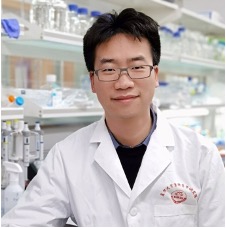
博士,青年研究员
地址: 上海市徐汇区东安路131号科研二号楼A3-017室
实验室主页:https://www.x-mol.com/groups/qu_qianhui
邮件: qqh@fudan.edu.cn
1.Yulin Chao#, Zixuan Zhou#*, Hao Xia#, Chuanhui Yang#, Tingting Li, Yi-quan Tang, Yilai Shu, Qian Ba*, Jiaxu Hong*, Dianfan Li*, Qianhui Qu*. Transport and inhibition mechanism for human TauT-mediated taurine uptake. Cell Research, 2025
2.Qi Xiong#, Zhini Zhu#, Tingting Li#, Xiaotian Li, Zixuan Zhou, Yulin Chao, Chuanhui Yang, Suihan Feng, Qianhui Qu*, Dianfan Li*. Molecular architecture of human LYCHOS involved in lysosomal cholesterol signaling. Nature Structural & Molecular Biology, 2025
3.Peipei Li#, Zhini Zhu#, Yong Wang#*, Xuyuan Zhang#, Chuanhui Yang#, Yalan Zhu#, Zixuan Zhou, Yulin Chao, Yonghui Long, Songqing Liu, Liguo Zhang*, Pu Gao*, Qianhui Qu*. Substrate transport and drug interaction of human thiamine transporters SLC19A2/A3. Nature Communications, 2024
4.Yuwei Wang#, Pei Zhang#, Yulin Chao#, Zhini Zhu#, Chuanhui Yang#, Zixuan Zhou#, Yaohui Li, Yonghui Long, Yuehua Liu, Dianfan Li, Sheng Wang*, Qianhui Qu*. Transport and inhibition mechanism for VMAT2-mediated synaptic vesicle loading of monoamines. Cell Research, 2024
5.Yonghui Long#, Zhini Zhu#, Zixuan Zhou#, Chuanhui Yang#, Yulin Chao#, Yuwei Wang, Qingtong Zhou, Ming-Wei Wang, Qianhui Qu*. Insights into the human zinc transporter ZnT1 mediated Zn2+ efflux. EMBO Reports, 2024
6.Shujin Liu#, Yulin Chao#, Zixuan Zhou#, Chuanhui Yang, Zhini Zhu, Yuwei Wang, Qianhui Qu*. Recognition of antiepileptic brivaracetam by synaptic vesicle protein 2A. Cell Discovery, 2024
7.Jingjing Hong#, Tingting Li#, Yulin Chao#, Yidan Xu, Zhini Zhu, Zixuan Zhou, Weijie Gu, Qianhui Qu*, Dianfan Li*. Molecular basis of the inositol deacylase PGAP1 involved in quality control of GPI-AP biogenesis. Nature Communications, 2024
8.Yidan Xu#, Tingting Li#, Zixuan Zhou#, Jingjing Hong, Yulin Chao, Zhini Zhu, Ying Zhang, Qianhui Qu*, Dianfan Li*. Structures of substrates- and products-bound glycosylphophatidylinositol transamidase illuminate GPI-AP biogenesis. Nature Communications, 2023
9.Yidan Xu#, Guowen Jia#, Tingting Li#, Zixuan Zhou#, Yitian Luo, Yulin Chao, Juan Bao, Zhaoming Su*, Qianhui Qu*, Dianfan Li*. Molecular insights into the biogenesis of glycosylphosphatidylinositol anchor proteins. Nature Communications, 2022